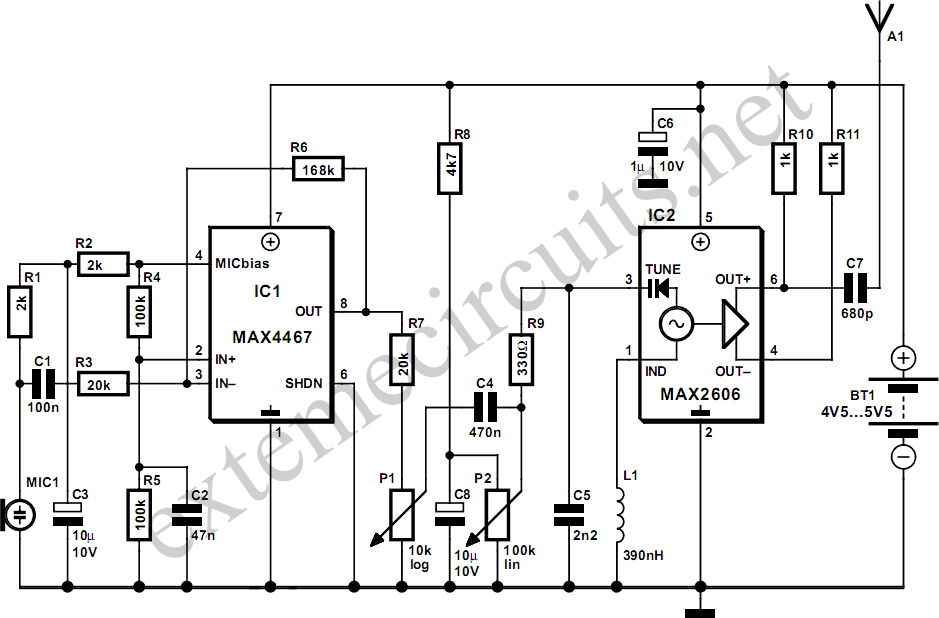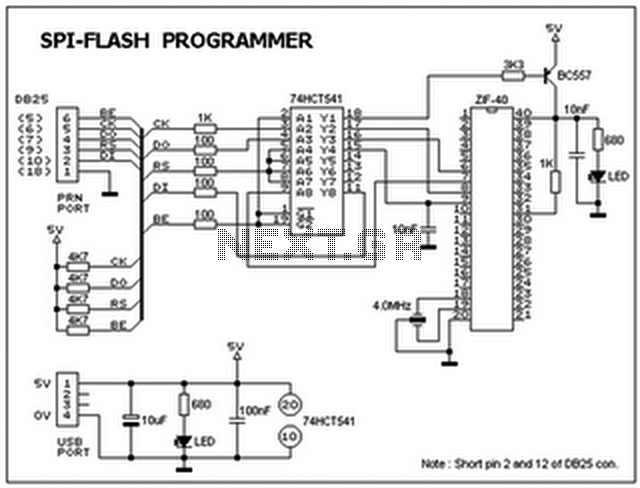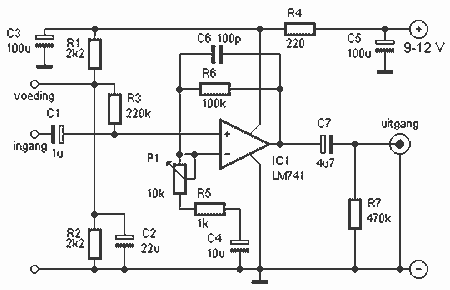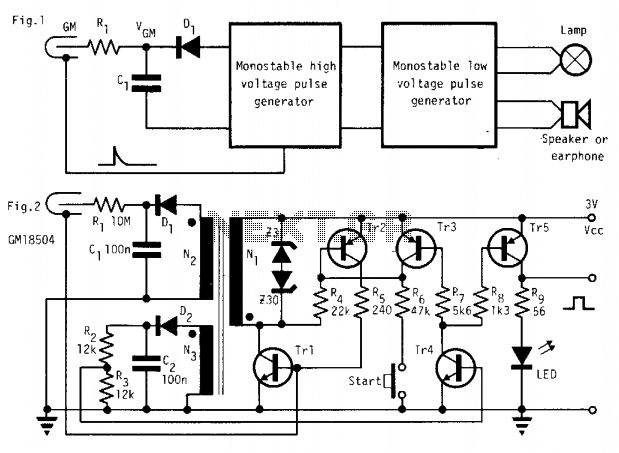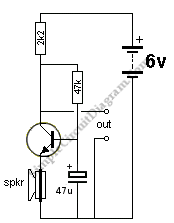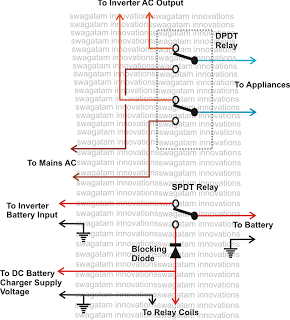
Micro Inverter by 2N6121
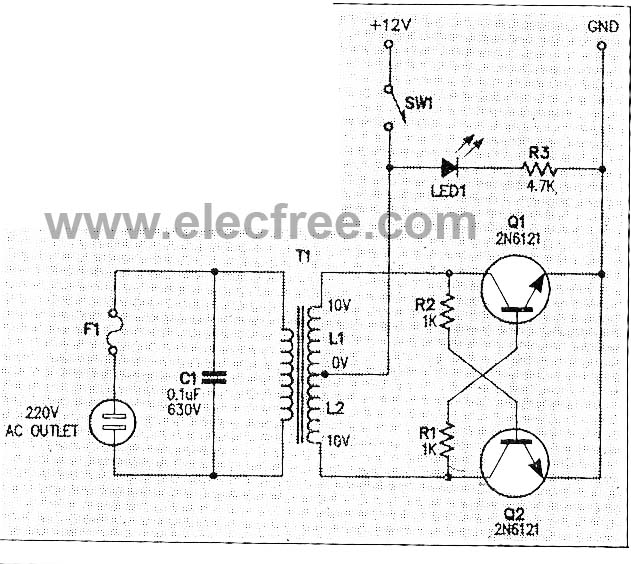
This micro inverter is a small-sized device that modifies energy from a battery, producing an output voltage of approximately 220V AC at 50Hz. The circuit comprises two transistors that function as a pulse oscillator or square wave generator, driving a transformer coil to achieve the desired voltage. The frequency can be adjusted by changing the resistor-capacitor (RC) values. The circuit typically operates at a current of about 100mA, depending on the transistors and transformer used. This inverter converts 12V DC battery power into AC voltage ranging from 180V to 220V, with frequencies between 30Hz and 65Hz. It is suitable for general electric devices with a power consumption of under 10 watts, such as compact fluorescent lamps, CD players, and small radios, which are more efficient than incandescent bulbs. The project utilizes a universal transformer and dual power transistors, allowing for easy assembly through simple wiring connections. The DC to AC conversion circuit includes an oscillator that uses a 12V DC source to drive current through a center-tapped coil. The dual power transistors operate in a push-pull configuration, alternating their states. When voltage is applied, one transistor reaches saturation faster than the other, creating a magnetic field in the coil. This action induces a base voltage through a resistor, causing the first transistor to switch off and the second to switch on. This process continues until the transformer core reaches saturation, at which point the current through the resistor decreases, eventually switching the first transistor back on and allowing the second to turn off. To ensure proper operation, mica insulators should be placed between the transistors and their cases, and an ohmmeter should be used to check for short circuits in the devices.
The micro inverter circuit is designed to be compact and efficient, making it suitable for various low-power applications. The use of a pulse width modulation (PWM) technique can further enhance the inverter's performance by allowing for finer control of the output voltage and frequency. By adjusting the RC components, the frequency of the output wave can be tailored to match the requirements of specific devices, ensuring optimal performance and compatibility.
In constructing the inverter, careful attention must be paid to the selection of transistors. Transistors with similar current gain characteristics are preferred, as they ensure balanced operation in the push-pull configuration. This balance is critical for minimizing distortion in the output waveform and maximizing the efficiency of the transformer.
The transformer plays a vital role in stepping up the voltage from the low DC level to the required AC level. A universal transformer with a center tap is ideal for this application, as it allows for easy implementation of the push-pull switching method. The design should also consider thermal management, as the transistors can generate heat during operation. Adequate heat sinking and ventilation must be provided to ensure reliable operation over extended periods.
The overall design emphasizes simplicity and ease of assembly, making it accessible for hobbyists and engineers alike. The use of standard components and straightforward wiring techniques allows for rapid prototyping and testing. Safety precautions should be taken during assembly and operation, particularly in checking for short circuits and ensuring proper insulation between components to prevent electrical hazards.This is Micro inverter or The inverter very small-sized, perform modify from the energy battery the small-sized, have the value voltage about 220V AC Volt 50HZ. By the circuit composes 2 transistors performs pulse oscillator generator or Square wave generator, for drive the coil transformer have voltage tall about 220V at 50Hz frequencies.
By can change the value RC when give the frequency can modify. This circuit have current about 100mA depend on the transistor and Transformer. The detail is other total up PCB see in a picture below. A voltage converter DCV into ACV always called that inverter circuit . Which this micro inverter circuit very tiny, acts as convert voltage from the 12 VDC battery to ACV in range of 180V to 220 V-AC, by have frequencies in range of 30Hz to 65 Hz. And can be used with a general electric devices so current consumption under 10 watt. Such as a small compact fluorescent, a CD player, a general small radio, as more popular than incandescent bulbs because the light-colored eyes and saves more power.
This inverter project use a universal transformer with a dual power transistors. We easily assemble all parts with wiring the joint only, because a small projects, so you`ve succeeded in making a good inline solder connection within five minute. The normally DC to AC converting circuit will include the oscillator circuit, that uses the source voltage is 12 Volts-DC, then drive current through a center trap coil.
By uses dual power transistors is a push-pull switching (working alternates) Both transistors should have current gain rates similar, but not necessarily equal When we apply voltage are in to this project. An one transistor will be saturation point (close circuit) faster than other, to set Q1 close circuit before.
The collector current of Q1, Therefore, to create a magnetic field in the. L2-coil then get a base voltage more through a R1-resistor. The Q1-transistor so into the close circuit state fast and making Q2 open circuit faster as well. This manner condition remained until the transformer core to saturation. Therefore, cause current flowing through R1 reduce until not enough makes Q1 is in close circuit state. On the contrary, while Q1 begins to change slowly. From the close circuit into opent circuit that, The Q2 also will start conductor higher. The current flowing through R2 will add bias to Q2, makes Q2 close circuit faster. Now the current from battery will flow reverses the direction in the coil-L1. Cause the induced voltage polarity is reversed in the secondary coil of transformer, Q2 will still conductor until transformer core to saturation point.
1. Use a mica insulator insert between case and body of transistor, then use a plastic insulator acts as hold the transistor body with hex nut and metal screw (as Figure 3) 3. Use ohmmeter check short circuit of various devices, does not short circuit with case. By used VOM set Rx1 range then point at leads of device, It must not read as 0 ohms. as Figure 4. 🔗 External reference
The micro inverter circuit is designed to be compact and efficient, making it suitable for various low-power applications. The use of a pulse width modulation (PWM) technique can further enhance the inverter's performance by allowing for finer control of the output voltage and frequency. By adjusting the RC components, the frequency of the output wave can be tailored to match the requirements of specific devices, ensuring optimal performance and compatibility.
In constructing the inverter, careful attention must be paid to the selection of transistors. Transistors with similar current gain characteristics are preferred, as they ensure balanced operation in the push-pull configuration. This balance is critical for minimizing distortion in the output waveform and maximizing the efficiency of the transformer.
The transformer plays a vital role in stepping up the voltage from the low DC level to the required AC level. A universal transformer with a center tap is ideal for this application, as it allows for easy implementation of the push-pull switching method. The design should also consider thermal management, as the transistors can generate heat during operation. Adequate heat sinking and ventilation must be provided to ensure reliable operation over extended periods.
The overall design emphasizes simplicity and ease of assembly, making it accessible for hobbyists and engineers alike. The use of standard components and straightforward wiring techniques allows for rapid prototyping and testing. Safety precautions should be taken during assembly and operation, particularly in checking for short circuits and ensuring proper insulation between components to prevent electrical hazards.This is Micro inverter or The inverter very small-sized, perform modify from the energy battery the small-sized, have the value voltage about 220V AC Volt 50HZ. By the circuit composes 2 transistors performs pulse oscillator generator or Square wave generator, for drive the coil transformer have voltage tall about 220V at 50Hz frequencies.
By can change the value RC when give the frequency can modify. This circuit have current about 100mA depend on the transistor and Transformer. The detail is other total up PCB see in a picture below. A voltage converter DCV into ACV always called that inverter circuit . Which this micro inverter circuit very tiny, acts as convert voltage from the 12 VDC battery to ACV in range of 180V to 220 V-AC, by have frequencies in range of 30Hz to 65 Hz. And can be used with a general electric devices so current consumption under 10 watt. Such as a small compact fluorescent, a CD player, a general small radio, as more popular than incandescent bulbs because the light-colored eyes and saves more power.
This inverter project use a universal transformer with a dual power transistors. We easily assemble all parts with wiring the joint only, because a small projects, so you`ve succeeded in making a good inline solder connection within five minute. The normally DC to AC converting circuit will include the oscillator circuit, that uses the source voltage is 12 Volts-DC, then drive current through a center trap coil.
By uses dual power transistors is a push-pull switching (working alternates) Both transistors should have current gain rates similar, but not necessarily equal When we apply voltage are in to this project. An one transistor will be saturation point (close circuit) faster than other, to set Q1 close circuit before.
The collector current of Q1, Therefore, to create a magnetic field in the. L2-coil then get a base voltage more through a R1-resistor. The Q1-transistor so into the close circuit state fast and making Q2 open circuit faster as well. This manner condition remained until the transformer core to saturation. Therefore, cause current flowing through R1 reduce until not enough makes Q1 is in close circuit state. On the contrary, while Q1 begins to change slowly. From the close circuit into opent circuit that, The Q2 also will start conductor higher. The current flowing through R2 will add bias to Q2, makes Q2 close circuit faster. Now the current from battery will flow reverses the direction in the coil-L1. Cause the induced voltage polarity is reversed in the secondary coil of transformer, Q2 will still conductor until transformer core to saturation point.
1. Use a mica insulator insert between case and body of transistor, then use a plastic insulator acts as hold the transistor body with hex nut and metal screw (as Figure 3) 3. Use ohmmeter check short circuit of various devices, does not short circuit with case. By used VOM set Rx1 range then point at leads of device, It must not read as 0 ohms. as Figure 4. 🔗 External reference
